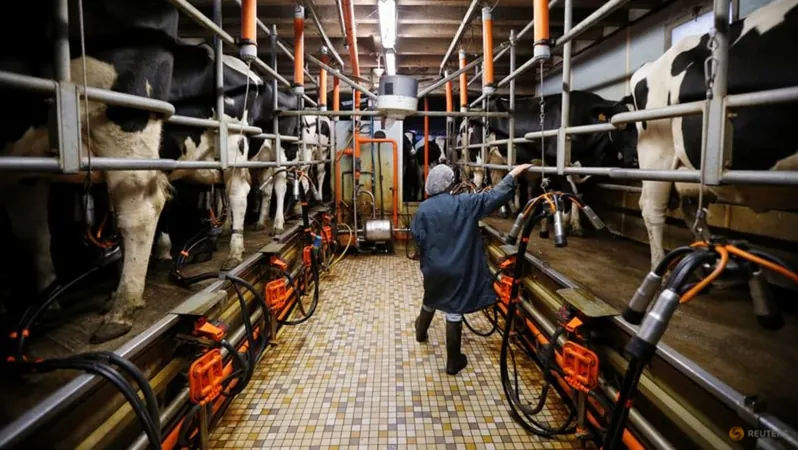
Europe Takes Bold Steps to Attract Youth to Save its Aging Agricultural Sector
2025-04-02
Author: Siti
Introduction
In a striking contrast to the aging demographic of the agricultural industry, 15-year-old Pauline Duval is making waves. The French teen is not just an ordinary teenager; she has been deeply involved in her family's farming operations since childhood, showcasing a passion for agriculture that many of her peers lack.
“I’ve always known that I want to take over the farm when my parents retire,” Pauline shared amid the hubbub of the Paris International Agricultural Show, where her impressive prize bull is the talk of the town. This event marks France's largest celebration of agriculture, and it encapsulates the nation’s struggle with a pressing demographic crisis in its farming sector.
Statistics Highlighting the Crisis
Statistics from the European Commission paint a concerning picture: only 12% of farms in the 27-member European Union are managed by individuals under the age of 40. This raises significant concerns about the future viability of agriculture in Europe, where traditions are at risk of dying out without a new generation stepping in.
European Commission's Roadmap
To confront this looming crisis, the European Commission is unveiling a comprehensive roadmap aimed at invigorating the agricultural workforce. Among the initiatives is the introduction of a revolutionary “agro-bachelor” diploma designed to enhance managerial and entrepreneurial skills specifically tailored for agriculture. This program is expected not only to prepare young farmers but also to attract those from non-farming backgrounds into the sector.
Challenges in Attracting Youth
However, creating interest among youth in agriculture has proved challenging, especially for those without familial ties to farming. Rural organizations, like the National Rural Family Homes Union, emphasize the need to imbue agricultural knowledge in young students from an early age. “It's essential that we raise awareness among primary school children, welcoming them to farms and training centers to spark their interest,” highlighted Benoit Lecaulle, a spokesperson for the organization.
He also underscored the importance of providing advanced training for those entering farming without prior experience.
Urgent Dilemma in the Farming Sector
As France's second-largest employer, the farming sector faces an urgent dilemma, with approximately half of its farmers set to retire by 2030. In response, the government has set ambitious targets to boost the number of trained agricultural workers by 30% over the next decade. President Emmanuel Macron has underscored the urgency of this undertaking, linking it not only to economic stability but also to national security. He stressed the geopolitical implications of food production: “In these tense times, we must consider that food could become a weapon in the future. Thus, our responsibility is to produce our own food for ourselves and future generations.”
Broader European Context
The challenges facing France are echoed across Europe, where the agricultural sector accounts for a little over 1% of the EU's total GDP. Despite this modest contribution, an astonishing one-third of the EU's budget is allocated to agricultural subsidies. In response to the pressing needs of farmers, European agriculture commission officials recently announced reforms designed to improve farmers' conditions and establish fairer supply chains.
Conclusion
As Europe grapples with an aging agricultural workforce, the question remains: will initiatives like the agro-bachelor program and government reforms be enough to attract the youth necessary to ensure the future of farming? The coming years will be crucial in determining whether the continent can successfully cultivate a new generation of farmers ready to take up the mantle.
Stay tuned as we continue to follow these developments in the quest to revitalize agriculture in Europe!
 Brasil (PT)
Brasil (PT)
 Canada (EN)
Canada (EN)
 Chile (ES)
Chile (ES)
 Česko (CS)
Česko (CS)
 대한민국 (KO)
대한민국 (KO)
 España (ES)
España (ES)
 France (FR)
France (FR)
 Hong Kong (EN)
Hong Kong (EN)
 Italia (IT)
Italia (IT)
 日本 (JA)
日本 (JA)
 Magyarország (HU)
Magyarország (HU)
 Norge (NO)
Norge (NO)
 Polska (PL)
Polska (PL)
 Schweiz (DE)
Schweiz (DE)
 Singapore (EN)
Singapore (EN)
 Sverige (SV)
Sverige (SV)
 Suomi (FI)
Suomi (FI)
 Türkiye (TR)
Türkiye (TR)
 الإمارات العربية المتحدة (AR)
الإمارات العربية المتحدة (AR)